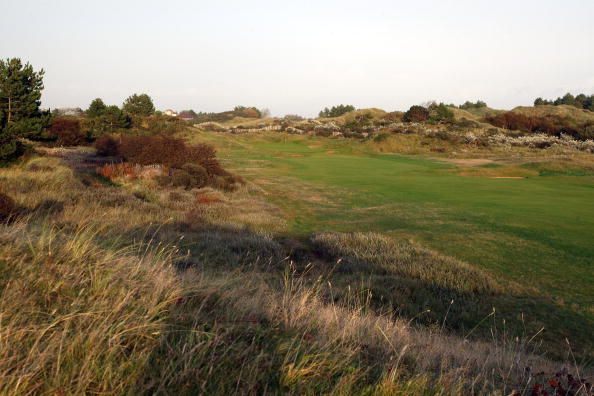Feel that stiff breeze coming off the Irish Sea? Mmmmm...must be Open Championship Week. This year, The Open returns to Royal Birkdale Golf Club for the 10th time since its first in 1954 and the first time since 2008, when Pádraig Harrington won his second Open Championship.
Club History
Birkdale Golf Club was founded in 1889, with the course being laid out by George Lowe, with revisions by Fred Hawtree and J.H. Taylor in 1931. The original nine-hole course was on Shaw Hills, behind Bedford Road to the south of East Ward. In 1897 the Club moved to the Birkdale Hills where an 18-hole course was constructed. The club was awarded "Royal" status in 1951. Maybe its most distinct feature is the sticks-out-like-a-sore-thumb-but-somehow-works art deco clubhouse that was designed to look like a ship sailing through the sand dunes. Built in 1935, it overlooks the 18th green (it will be shown a lot this week as there’s nothing else like it in the Open rota).
The Course
The course as it’s played today is far more the product of the Hawtree & Taylor design than Lowe. Their philosophy was to lay out holes in the valleys between the sand hills rather than over them. This enabled Birkdale to gain the reputation of being one of the fairest of the championship courses. While it’s closer in keeping with the American concept of target golf, with its well-defined fairways and greens, the course rewards good shots and punishes bad ones. Which is why professionals respect the course so much. It’s very much a ‘you get what you hit’ type of course. They designed a course which was tough but fair. It rewards the straight hit but punishes the wayward shot with its surrounding buckthorn and dwarf willow scrub. The fairways are threaded through the valleys and this has left the mighty sand dunes as perfect natural vantage points for spectators.
As with most links courses, the largest natural defense to scoring is the wind. The manner in which the course is situated (just 18 miles north of Liverpool in Southport) and routed (hole alignment is 90 degrees or more from the previous hole) it is no more imperative to hit fairways, even if forsaking distance, than at Royal Birkdale. Many of the holes typically play in cross-winds that can wreak havoc on players that are only comfortable moving the ball in one direction. Additionally, because the holes are basically all in dune corridors the ground (fairways) are relatively flat allowing players to avoid many awkward stances.
Holes to Watch

Hole 1 - Par 4, 448 yards
Maybe the toughest opening hole in the Open rota, players need to be ready to play from the opening tee ball. There’s no easing into your round on this hole. With one of only two O.B. lines on the property to the right of the fairway, and a pot bunker 235 yards on the left side guarding the inside of the small dogleg, and the prevailing wind into from the player's left...all signs point to OB if you miss just slightly right with a driver. Assuming a player hits the narrow strip of fairway, they are typically left with a mid-iron into the wind where the right side of the green is partially obstructed by a large dune. All equating to the being the second hardest for the Championship back in 2008 with an average score of 4.52.
Hole 6 - Par 4, 499 yards
A hugely dramatic hole, the prevailing wind is from the right (another crosswind from the tee) as the hole bends to the right thus creating a headwind for the approach shot. To make matters even more interesting/difficult, the hole’s land creates a reverse dogleg (bending one direction with the ground sloping the opposite way) repelling shots out of the fairway. With a bunker 275 yards from the tee on the right, in benign conditions players would fly that easily. However, into the crosswind carrying the bunker requires hitting a landing area that can’t be more than 5 yards wide. Thread meet needle. The “safer” play is a long iron or fairway wood off the tee leaving a 200+ yard approach into the wind to an elevated green with bunkers short left and right. Good luck. No wonder during the entire Championship in 2008 there were only 10 birdies total made on the hole. Making it the most difficult hole on the course with a 4.77 average score.

Hole 17 - Par 5, 567 yards
From the hardest hole to the easiest hole. Playing directly downwind, viewers are going to see some absolutely massive drives on this hole. Two fairway bunkers are 312 and 325 yards from the tee. You don’t think DJ or Koepka or Rory are airmailing those in the right conditions? Once in the fairway, there’s pseudo-cross bunker yard 40 yards short of the green preventing a complete ground approach. The green complex had been modified for this year’s Open with it's most extreme contours alleviated.

Hole 18 - Par 4, 473 yards
One of the most iconic finishing holes in the Open rota (from Justin Rose’s hole-out to Nicklaus’ famous concession to Tony Jacklin in the 1969 Ryder Cup) it begins from an extreme angle from the right that bring OB into play (just like on the 1st hole) on the tee shot. Much like the 17th it typically plays with a helping wind from the left. There are bunkers to be avoided at 275, 306, and 349 yards from the tee making for a pretty treacherous landing zone. The green is tightly guarded by bunkers and is notoriously difficult to hold with an approach shot. Overall, an exciting finishing hole for The Open.

